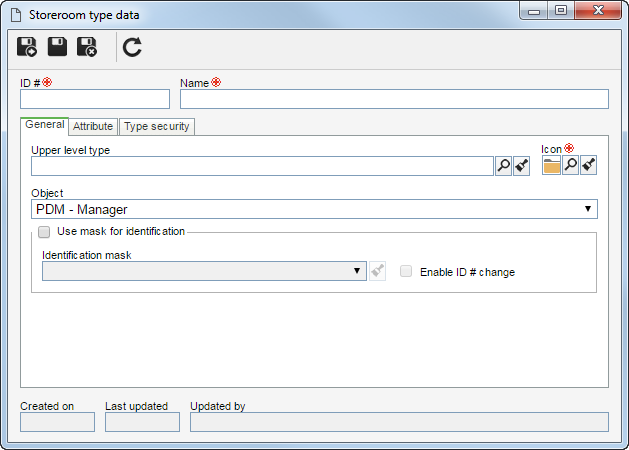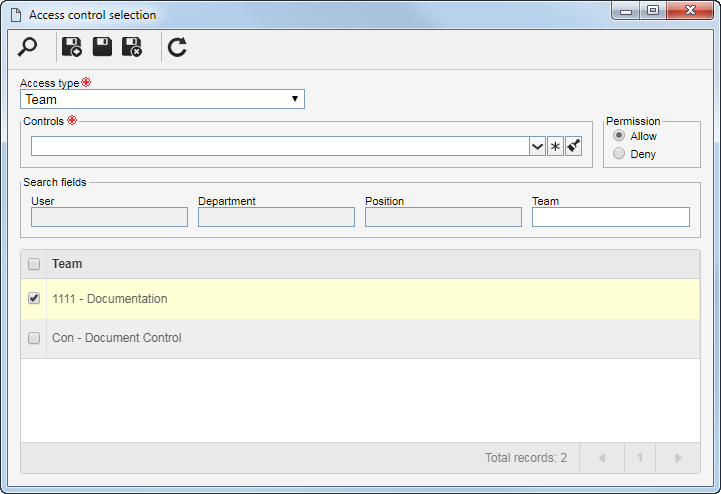|
To configure a new storeroom type, in the main screen toolbar, click on the  button. To edit the data of a type, select it in the list of records and click on the button. To edit the data of a type, select it in the list of records and click on the  button. button.
Fill out the ID # and the name of the type data screen that will be opened:

The following tabs will be available to be filled out:
Field
|
|
Upper level type
|
Select the item type that, in the main screen hierarchy, is one level above the storeroom type in question. This field will be filled in by the system if, on the main screen hierarchy, a storeroom type is selected; however, it is possible to edit it.
|
Icon
|
Select the icon that will represent the storeroom type.
|
Object
|
Select the object types that will be stored in the storerooms of this type: input, item (PDM) or waste. For this feature to work correctly, the SE Supply, SE PDM, and SE Waste components must have an active license key in SE Suite.
|
Use mask for the ID #
|
Check this option to use the automatic identification feature when creating storerooms of this type. Fill in the following fields:
▪Identification mask: Select the desired identification mask. Note that only identification masks configured with a Storeroom object will be available for selection. ▪Enable ID # change: Check this option to allow the generated identifier to be edited when creating storerooms of this type. If this option is not checked, the generated identifier may not be edited. |
|
Use this tab to associate the attributes that complement the information of this storeroom type.

|
Click on this button to associate an attribute that was previously created in the system with the record. Refer to the Adding attributes section for further details on how to perform this operation.
|

|
Click on this button to save the association of attributes with the record.
|

|
Click on this button to disassociate the attribute selected in the list of records from the record.
|
If changes are made to the attribute configurations (for example: an attribute previously checked as required is no longer required or vice-versa), they will be replicated to the storerooms of this type when their data is edited.
|
|
See how to define the storeroom type security:
1.
|
First, at the top of the tab, select one of the following options:
▪Public: Any SE Storeroom user will have access permission to the storeroom type. ▪Restricted: Only determined SE Storeroom users will have access permission to the storeroom type. When selecting this option, the toolbar buttons in the list of records will become enabled. Click on the  button and fill out the following fields on the data screen that opens: button and fill out the following fields on the data screen that opens:

|
2.
|
In the Access type field, select one of the following options to define the access type that will make up the security list:
▪Team: It will be composed of the members of a team previously created in SE Storeroom. ▪Department: It will be composed of users from a selected department. ▪Department/Position: It will be composed of users from a specific department of the company, who have a specific position. ▪Position: It will be composed of users who hold specific position in the company. ▪User: It will be composed of a specific user. ▪All: It will be composed of all users who have access to the SE Storeroom component.
|
3.
|
According to selected access type, the Search filters will be enabled to be filled out. Use them to make the search for the users who will make up the security list more easily.
|
4.
|
Use the Controls field to select the actions that may or may not be performed in the storeroom type in question. To do so, select the controls that will be granted to the previously selected access type:
▪Add: Add new storeroom types to levels below the type in question. ▪Edit: Edit the data of the storeroom type. ▪Delete: Delete the record of the storeroom type. ▪Security data: Edit the security data of the storeroom type. Users who have this control denied or not enabled may edit the other data of the storeroom type; however, the Type security tab will be blocked. ▪List: View the type in question on the system screens that display the storeroom type hierarchy. Users who have this control denied or not enabled will not see the type in question in the storeroom type hierarchy. ▪View: View the data screen of the storeroom type.
Use the buttons next to the field to expand and view the control list, select all the available controls, and clear your selection, respectively.
|
|
5.
|
Select, in the Permission field, whether the controls selected previously will be allowed or denied to the access type.
|
6.
|
After filling the fields above, click on the  button on the selection screen toolbar. button on the selection screen toolbar.
|
7.
|
The result will be displayed in the list of records at the bottom of the screen. Select those that will make up the security list of the storeroom type. Use SHIFT or CTRL on the keyboard or the checkbox next to each item to select more than one record at a time.
|
8.
|
Save your selection.
|
Use the other toolbar buttons to edit the data or delete an access selected in the list of records.
|
|
After filling in all the necessary fields, save the record.
|







